
Prickly Hornwort
Ceratophyllum echinatum
Also Known As - Spineless HornwortWatering:
Minimal
Hardiness Zone:
Sun:
full sun,part shade
Leaf:
Yes
Growth Rate:
Low
Salt Tolerant:
Yes
Care Level:
Medium
watering
Water Horn-Seed Buttercup (Ceratocephala testiculata) regularly, usually once a week. Make sure to provide enough water to moisten the soil, but not too much that the soil becomes soggy. During the hotter months, increase watering frequency to 2 or 3 times a week to prevent the soil from drying out. In cooler weather, reduce the watering frequency to once a week. If the soil appears to be dry, it's time to water the plant.
sunlight
Horn-Seed Buttercup (Ceratocephala testiculata) is an emerging plant species native to western North America. It prefers full sun to partial shade, and prefers to receive direct sunlight throughout the day. During summer months, Horn-Seed Buttercup should receive approximately 6 hours of direct sunlight daily. For maintenance and actively growing plants, they should receive full sun for at least 8 to 10 hours a day. During the winter months, however, the plant should not be exposed to more than 4 to 6 hours of direct sunlight in order to prevent it from becoming overly stressed or harmed by the cold temperatures.
pruning
Horn-Seed Buttercup (Ceratocephala testiculata) should be pruned to 2 or 3 nodes above the soil line in late winter or early spring. By pruning the top growth, the plant can be kept to a manageable size and will encourage a better flowering display. It is best to avoid heavy pruning, as this may result in the plant becoming woody or overgrown.
